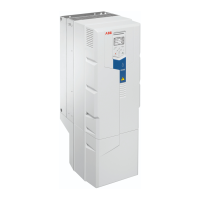264 Parameters
Even wear The running time of the motors are balanced by the drive.
When the difference in running time between the motors with
the least and most running hours exceeds the time defined by
parameter 76.72 Maximum wear imbalance, the autochange
occurs.
The running hours of the motors can be found in group 77
Multipump maintenance and monitoring
13
Other [bit] Source selection (see Terms and abbreviations on page 100). -
76.71 PFC Autochange
interval
Specifies the interval that is used in setting Fixed interval of
parameter 76.70 PFC Autochange.
1.00 h
0.00…42949672.95
h
Time. 1 = 1 h
76.72 Maximum wear
imbalance
Specifies the maximum wear imbalance, or difference in
running times between any motor, used by the Even wear
setting of parameter 76.70 PFC Autochange.
10.00 h
0.00…
1000000.00 h
Time. 1 = 1 h
76.73 Autochange level Upper speed limit for the Autochange to occur. The
Autochange occurs when:
• the condition defined in 76.70 PFC Autochange is fulfilled
and,
• the speed of the drive motor 01.03 Motor speed % is below
the speed limit defined in this parameter.
Note: When the value is selected as 0%, this speed limit
check is disabled.
100.0%
0.0…300.0% Speed/frequency in percentage of the nominal speed or
frequency of the drive motor.
1 = 1%
76.74 Autochange
auxiliary PFC
Selects whether only auxiliary motors or all motors are
included in the Autochange function.
Aux motors
only
All motors All motors, including the one connected to the drive
participates in the autochange. The Autochange logic will
connect the drive to each of the motors according to setting of
parameter 76.70 PFC Autochange.
Note: The first motor (PFC1) also requires the appropriate
hardware contactor connections and PFC1 must be defined
in one of the relay output source parameters.
0
Aux motors only Only auxiliary (direct-on-line) motors are affected by the
autochange function.
Note: PFC1 refers to the motor that is fixed to the drive and
must not be selected in any of the relay output source
parameters. Only the starting order of the auxiliary motors will
be rotated.
1
76.76 Max stationary time Defines the maximum time that a low priority pump can be
stationary.
The IPC system uses pump priorities to start/stop the pumps.
This parameter sets the upper limit for stationary time so that
the pump blockage can be avoided.
0.0
0.0...214748368.0 h Maximum stationary time in hours. 1 = 1 h
76.77 Pump priority Selects the priority of the pump in an IPC system.
Note: Parameter 76.76 Max stationary time defines the
maximum time that a low priority pump can be stationary.
Normal
No. Name/Value Description Def/FbEq16

